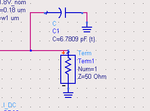orz
Junior Member level 2
anyone can help me? Thx!
my active inductor's impedance in 2GHz is 1.103+j*463.194, so you can replace this circuit with a resistance and inductance in series. and the res is 1.103 Ohm with the inductance of 36.86nH.
now i put a cap(6.7809pF) on the input port like this:

the value of cap is calculated according to the rule below:
the admittance of my circuit is Y=jwc+1/(jwL+R), so if i want it to resonate in 2GHz, the imaginary part should be zero.
(note: because the impedance of active inductor changes vs freq, a choose the resonant freq in 2GHz.)
however , the imaginary part isn't zero in 2GHz, Why? please help! Thank you!

my active inductor's impedance in 2GHz is 1.103+j*463.194, so you can replace this circuit with a resistance and inductance in series. and the res is 1.103 Ohm with the inductance of 36.86nH.
now i put a cap(6.7809pF) on the input port like this:

the value of cap is calculated according to the rule below:
the admittance of my circuit is Y=jwc+1/(jwL+R), so if i want it to resonate in 2GHz, the imaginary part should be zero.
(note: because the impedance of active inductor changes vs freq, a choose the resonant freq in 2GHz.)
however , the imaginary part isn't zero in 2GHz, Why? please help! Thank you!
